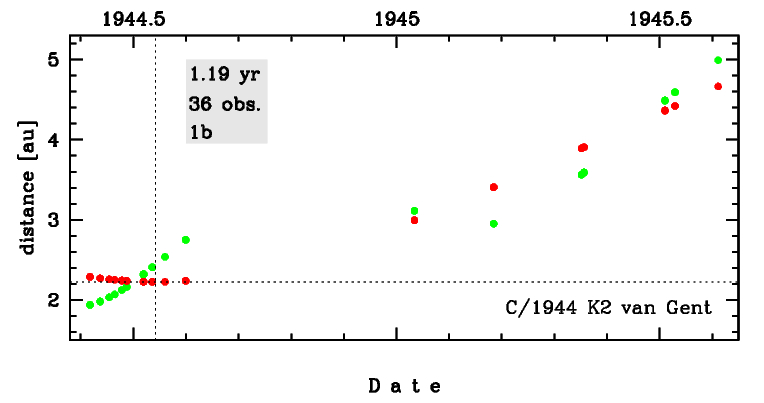C/1944 K2 van Gent
more info
Comet C/1944 K2 was discovered on 23 May 1944 by Hendrik van Gent (Union Observatory, Johannesburg, South Africa). Soon, the prediscovery image from 15 May was found by van Gent. At the moment of discovery, the comet was about two months before perihelion passage, and it was last seen on 11 August 1945. [Kronk, Cometography: Volume 4].
This comet made its closest approach to the Earth on 20 May 1944 (1.913 au), that is three days before its discovery.
Solution given here is based on data spanning over 1.19 yr in a range of heliocentric distances from 2.288 au through perihelion (2.226 au) to 4.664 au.
This Oort spike comet suffers moderate planetary perturbations during its passage through the planetary system that lead to escape the comet from the solar systemon a hyperbolic orbit (see future barycentric orbits).
More details in Królikowska et al. 2014.
This comet made its closest approach to the Earth on 20 May 1944 (1.913 au), that is three days before its discovery.
Solution given here is based on data spanning over 1.19 yr in a range of heliocentric distances from 2.288 au through perihelion (2.226 au) to 4.664 au.
This Oort spike comet suffers moderate planetary perturbations during its passage through the planetary system that lead to escape the comet from the solar systemon a hyperbolic orbit (see future barycentric orbits).
More details in Królikowska et al. 2014.
| solution description | ||
|---|---|---|
| number of observations | 36 | |
| data interval | 1944 06 01 – 1945 08 11 | |
| data type | perihelion within the observation arc (FULL) | |
| data arc selection | entire data set (STD) | |
| range of heliocentric distances | 2.29 au – 2.23 au (perihelion) – 4.66 au | |
| detectability of NG effects in the comet's motion | NG effects not determinable | |
| type of model of motion | GR - gravitational orbit | |
| data weighting | YES | |
| number of residuals | 56 | |
| RMS [arcseconds] | 1.58 | |
| orbit quality class | 1b | |
| orbital elements (heliocentric ecliptic J2000) | ||
|---|---|---|
| Epoch | 1944 06 01 | |
| perihelion date | 1944 07 17.61179559 | ± 0.00186772 |
| perihelion distance [au] | 2.22594125 | ± 0.00001342 |
| eccentricity | 1.00205322 | ± 0.00002843 |
| argument of perihelion [°] | 336.973475 | ± 0.000686 |
| ascending node [°] | 203.500207 | ± 0.000194 |
| inclination [°] | 95.004881 | ± 0.000159 |
| reciprocal semi-major axis [10-6 au-1] | -922.40 | ± 12.77 |
